For a number of reasons, it's a great idea to have a stock of non-perishable foods in case of emergency, such as financial stress or natural disaster. Here are several ways to build up an emergency stock without overspending.
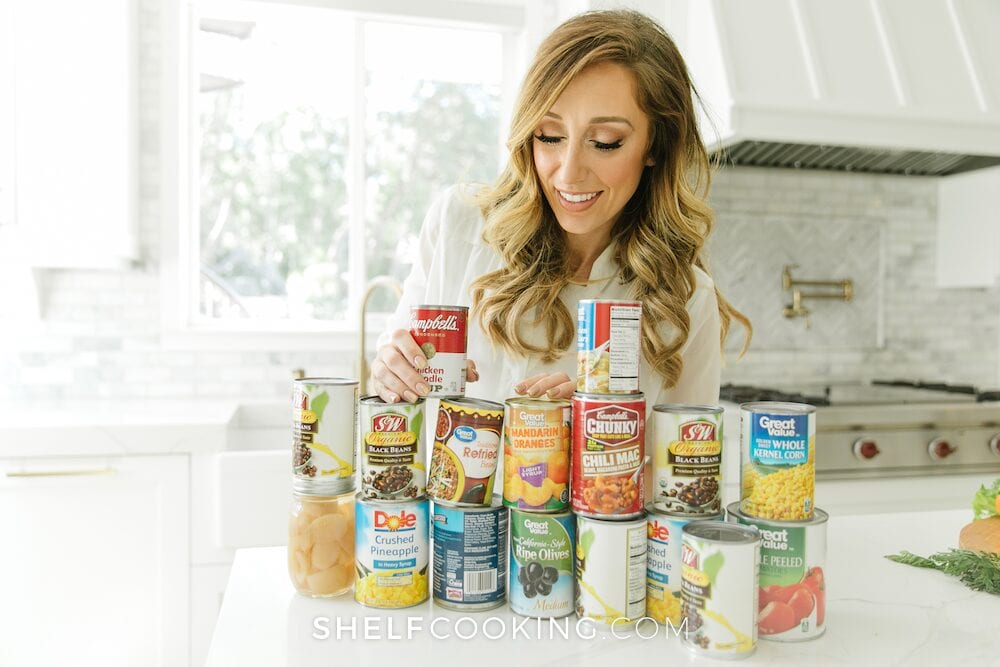
*Note: When you click the links in this post, we may receive a commission at no extra cost to you.
WHAT IS EMERGENCY PREPAREDNESS?
Emergency preparedness isn't about a hypothetical zombie apocalypse. There are so many real life situations that can pop up unexpectedly where you will benefit from an emergency stock of food and supplies! “Emergency preparedness” means building up a reserve of necessities and supplies that you can utilize in case of a crisis. In a world with natural disasters and power outages, it provides peace of mind that you and your family will be okay should any type of access to necessities be limited.
Bubba and I go into detail in the YouTube video below about our own experience with building up an emergency preparedness stock. We keep it light-hearted and fun (as per usual) and try to show you that “prepping” doesn't have to be expensive, time-consuming, or stressful. So check it out and just start small in getting some basic necessities for your family!
Watch the video online or click and watch below to see how we do our emergency preparedness:
See, we aren't trying to instill any fear with this topic! It's really quite the opposite. Putting together an emergency stock makes the possibility of some kind of emergency less scary because you've already ensured your family has basic necessities. So let's talk about some affordable way to stock up!
WHAT ITEMS SHOULD I STOCK UP ON IN MY EMERGENCY PREPAREDNESS KIT?
We can't give you an EXACT list because needs will vary family to family. It's dependent on your family's size and ages, any medications, the climate where you live, pets, etc. Instead, we'll give you a general overview of categories to consider and what food items we prefer to keep in our stock!
We are primarily going to be covering the food aspect to your emergency preparedness kits in this blog post. However we encourage you to do some research into other non-food necessities that are wise to keep on hand, such as: first aid supplies and medicines, cooking essentials like a pot, utensils and knife, baby supplies if applicable, batteries, flash lights and lighters.
The types of food that are best for emergency storage are non-perishables, freeze-dried goods, and rotatable goods. Non-perishables are items that have a shelf life of up to 30 years. These include:
- Oats
- Rice
- Pasta
- Beans
- Sugar
- Potato flakes
- Powdered milk
- Dehydrated fruits and vegetables
- Salt
- Baking oils
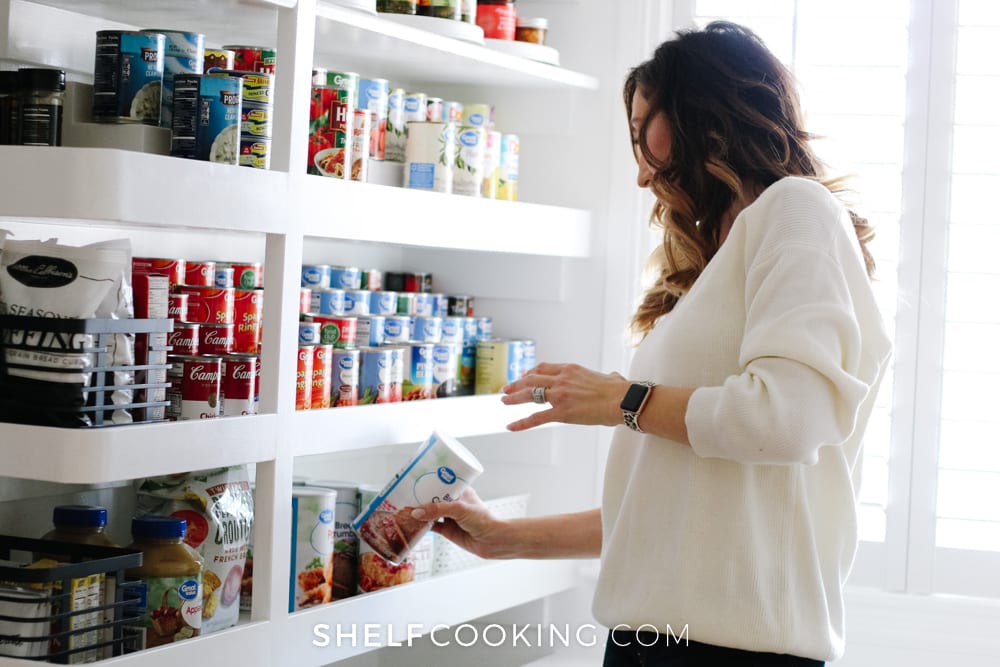
Rotatable goods are canned and jarred products that still have a decent shelf life, but will expire in the next few years. We never want to let food go to waste by exceeding its expiration date. Once we build up our stock of these types of foods, we can pull from them in our normal day-to-day cooking, as long as we replace them the next time we go shopping. We rotate through them by continuing the make use of the oldest items and avoiding waste due to expiration.
- Canned chicken and fish
- Peanut butter
- Canned beans
- Canned fruits
- Canned vegetables
- Canned soups
- Cereals
- Granola bars
- Spaghetti sauce
- Dried fruits
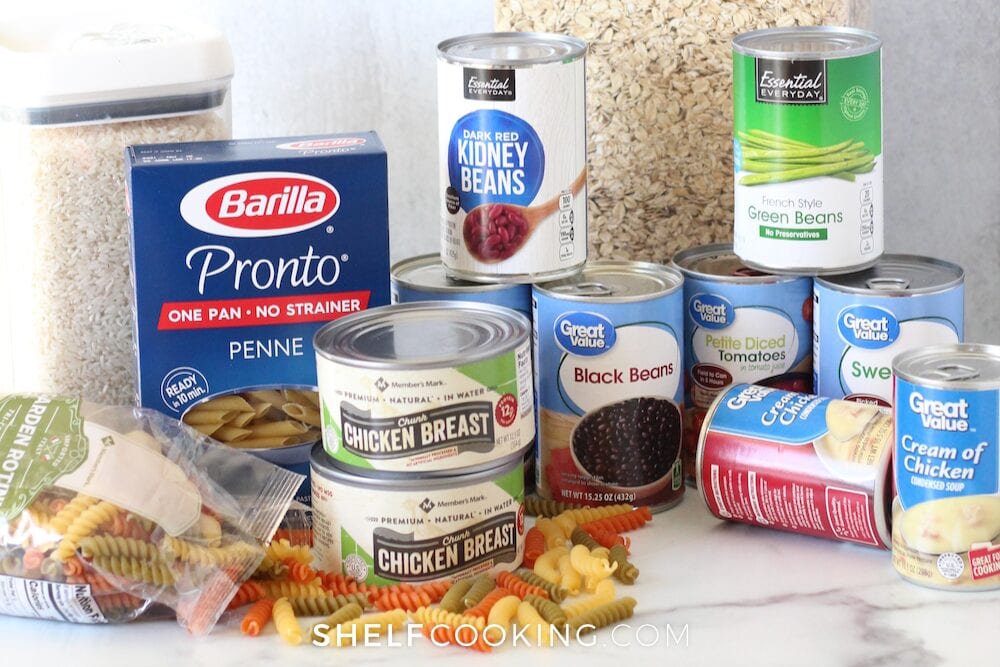
We prefer freeze dried foods as opposed to dehydrated foods. Freeze dried foods maintain their flavor AND nutrients, and can last for 20 years in room temperature! Freeze dried foods for long-term food storage can be an investment though. They do cost significantly more than grocery store staples because of the nature of surviving 20+ years. Our family tested out tons of brands, and we have come to love Thrive Life. The taste of the food is just superior, not to mention the CRAZY VARIETY they offer. I mean, freeze dried cake bites?! If I'm in an emergency, I want cake bites in my life!
Thrive Life occasionally runs case lot sales which are great times to stock up on freeze-dried foods. Thrive Life also offers a monthly subscription plan to build your stock over time, and this monthly auto-ship option also comes with a greater discounted price per unit.
HOW TO STOCK UP AFFORDABLY
There are many ways to build up your stock without blowing your grocery budget. In fact, many of these tips are applicable for your normal weekly grocery shopping and stocking up for shelf cooking!

- Stock up SLOWLY: no one said you needed to build up your entire food storage stockpile in one day! You can use even just $5-10 of your grocery budget per week to use towards items that will be stored in your emergency preparedness stock. Over time, this will create a significant stockpile.
- Buy One for Now, Two for Later – If you follow Shelf Cooking on Instagram, then you're probably very familiar with this tip! It's simple. Let's say you're buying canned soups for lunches this week, and they're marked down 50% off. Take advantage of that deal and buy however many you need for this weeks' meals plus twice as many more to store away. Before long, you'll have a stockpile of soups, and you'll be able to spend less and less at the grocery store to keep your family fed.
- Ask for Emergency Prep for gifts: One way to save money on an emergency prep kit would be to ask for a pre-made 72-hour kit (they sell these at Costco or other specialty stores) or specific components for gifts for Christmas, birthdays, wedding registry, etc.
- Use a Price Notebook to Know a Good Deal: How will you know what's a GREAT price if you don't have some concept of a normal price? I literally carried a notebook and pen around the stores with me for years until I learned what are standard prices for the majority of the items I buy. That way, I can easily decide if a sale or a discount is truly worthy of stocking up for!
- Buy generic store brands: We're preparing for a crisis here, so having a pretty label on your oats really doesn't need to be a priority. Store brands are typically significantly cheaper than name brands, and often times they are nearly identical products!
- Buy in bulk: When it makes sense, you can save a whole lot of dough by buying in bulk. Portion out what you need for the week, and save the rest for later! Just don't fall for the bulk deals that end up costing you more money. We've got some helpful advice about how to stock up and shop in bulk.
- Take advantage of sales with freeze-dried food companies like Thrive Life: You have the option to set up auto shipments each month to receive bigger discounts. Buy during their case lot sales, which is happening April 18th, 2023!
- Keep an Inventory: It's tough to stock up on foods (or shelf cook) if you don't know what you have on hand! We can’t emphasize enough how important it is to stay organized a keep a running inventory of the food you have available in your pantry, fridge, and freezer. It’s a bit of work, but it will save you SO much time! Use these free kitchen inventory printables to get started!
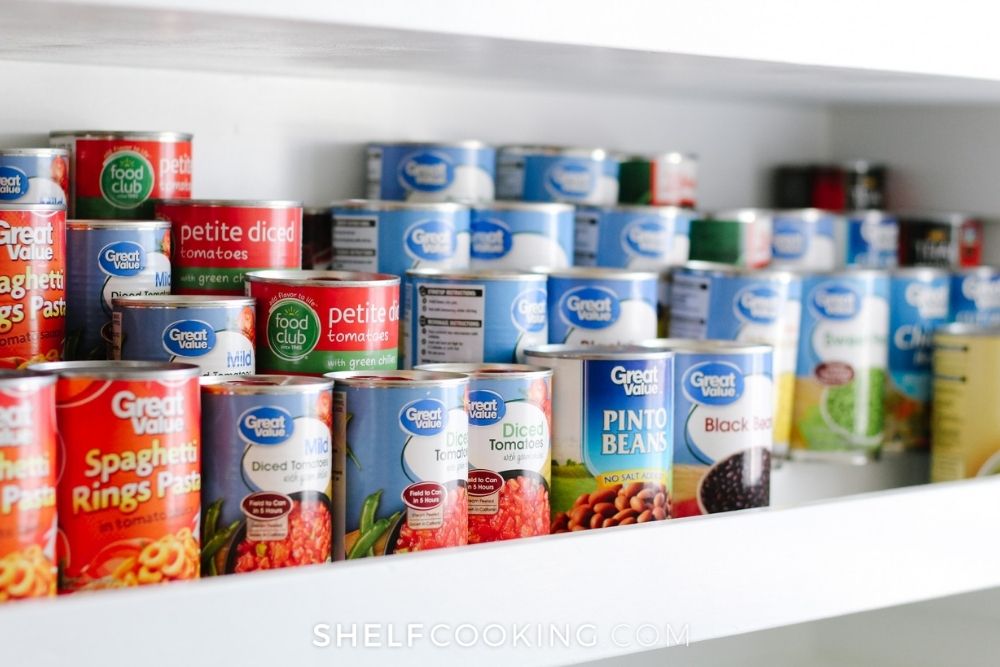
Use these guidelines to stock up smarter, and over time you will develop a fantastic stockpile without a giant dent in your grocery budget.
HOW TO ROTATE STOCK TO AVOID WASTE
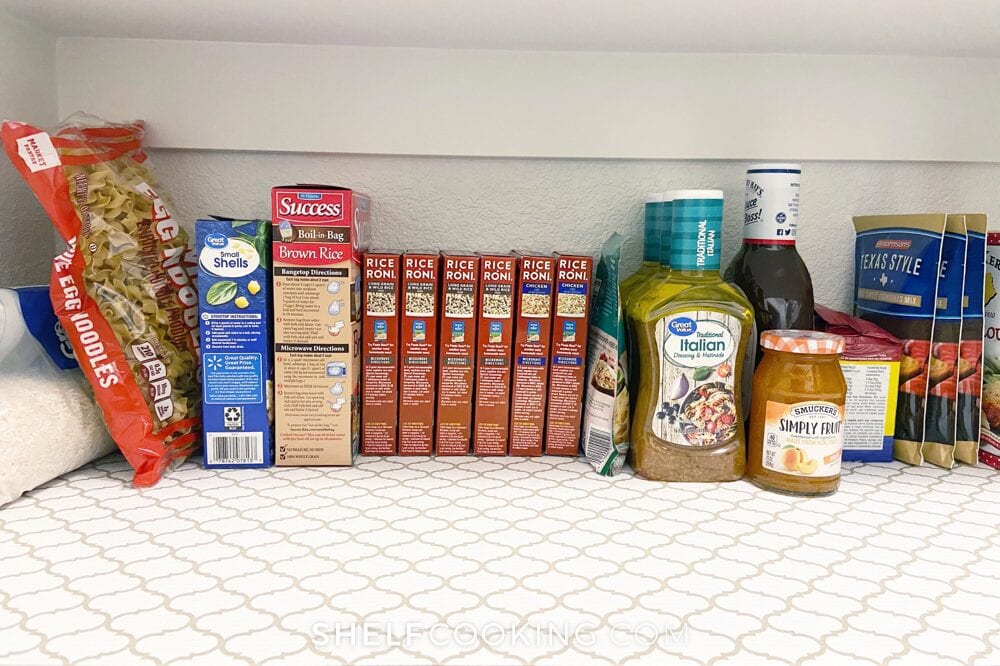
Some families are happy with a 72-hour emergency prep kit, which is the minimum recommended length of time from the US government. Other families like to increase that goal to 3-month's of storage, and serious preppers even aim to store up a full year's worth. It's up to YOU to determine a goal for the length of time you'd like to prepare for. Once you feel that you have adequately stocked your food storage, you are going to want to rotate through any items with upcoming expiration dates to avoid waste!
SO – if peanut butter is included in your food storage, make sure to use the oldest container and replace it next time you go shopping!
- 1.) Identify expiration dates on items.
- 2.) Store like foods together with the OLDEST items in the very front and the NEWEST items in the back.
- 3.) When you need to open a new container/jar/can of something, grab the oldest item.
- 4.) Add that item to your next grocery list to replace it!
- 5.) Store the new item to the back of the stock.
We recommend setting a recurring reminder on your calendar to review and refresh your emergency preparedness stock every 6 or 12 months. This is a great time to make sure you aren't at risk of wasting any foods with expiration dates. It can also apply to any non-food items in your kit, including clothing and batteries to make sure they still fit and work.
START STOCKING!
Okay, you are now prepared to prepare! Remember, we aren't creating an emergency preparedness stock out of fear. It's truly a practical effort in today's world! And don't forget about the current sale going on with Thrive Life.
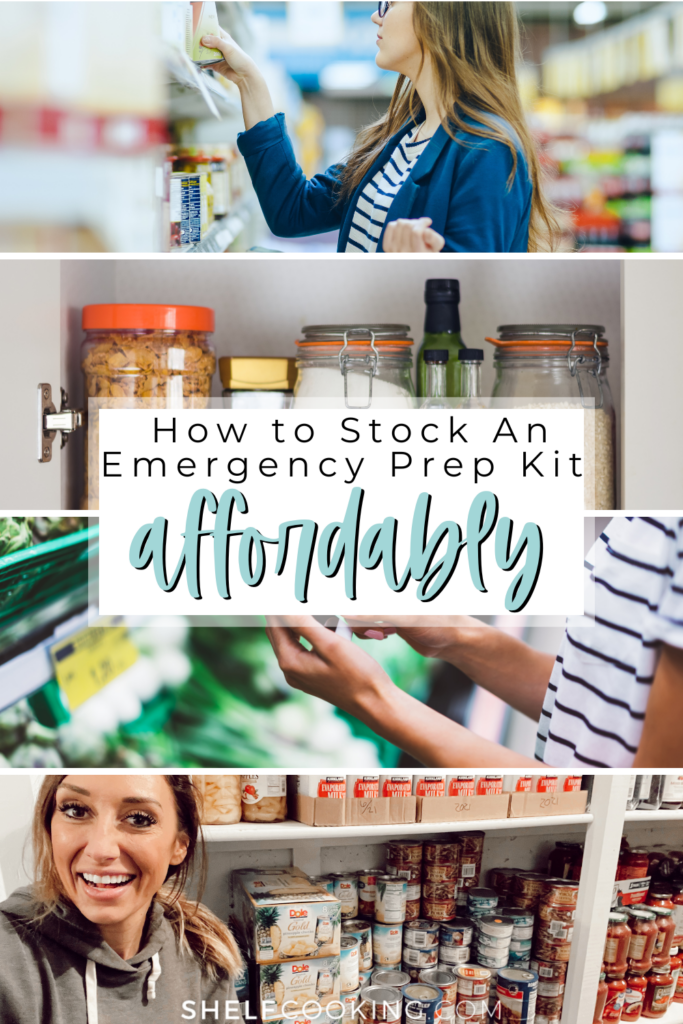
Here are some other great resources we've put together for you about stocking up your pantry, fridge and freezer affordably!
- Using Our Stocktober Challenge to Stock Up On A Budget!
- More Great Tips for Grocery Shopping on a Budget
- In case you didn't know, we aren't big coupon clippers. There are so many great ways to save on groceries, no scissors required!


great tips, those are perfect also fo rwho wants spend les son grocery monthly and have items already in house helps a lot!!!